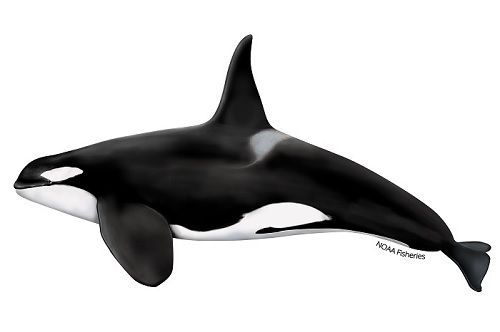 The endangered Southern Resident killer whale is an icon of the Pacific northwest and inspires widespread public interest, curiosity, and awe around the globe. Southern Residents are also among the most contaminated marine mammals in the world.
The endangered Southern Resident killer whale is an icon of the Pacific northwest and inspires widespread public interest, curiosity, and awe around the globe. Southern Residents are also among the most contaminated marine mammals in the world.
The population census in the summer of 2014 counted only 78 whales. In 2003, NOAA Fisheries began a research and conservation program with congressional funding, and the Southern Residents were listed as endangered in 2005 under the Endangered Species Act.
The population continues to struggle and has declined over 10 percent since 2005. We have come a long way in our understanding and ability to protect this unique population and in 2014, we summarized a decade of research and conservation activities in a special report.

Threats
Noise and overcrowding from boat traffic, as well as a scarce supply of their preferred food—salmon—pose serious threats to this endangered population. We need to focus efforts and make critical investments within NOAA Fisheries and continue to engage vital partners to stabilize and prevent the Southern Resident killer whale’s extinction. Past research has shown that some of the most important threats facing the whales, such as prey limitation and high contaminant levels, cannot be addressed without a long-term commitment. Recovery of threatened salmon, for example, is a monumental task in itself and is expected to take many years.
The threat of contaminants is also challenging, particularly considering that the whales remain contaminated by chemicals that were banned decades ago. Some mysteries also persist. For example, will increases in salmon abundance benefit the Southern Resident whales, or will any increases be consumed by other populations such as the Northern Resident killer whales? Are there health issues, like disease, that we have not yet uncovered? We also must consider new threats and actions as we look to a future with climate change, new alternative ocean energy projects, and continuing development along our coasts and in our ports. In the next 5 to 10 years, several high-priority projects are planned to help answer these remaining questions and inform management actions to advance recovery.
Recovery
With 10 years of funding, collaboration, and ingenuity we have taken substantial and important steps to aid Southern Resident killer whale recovery. Research projects have illuminated new aspects of killer whale biology, behavior, and ecology and helped us better understand the challenges this population faces. Targeted management actions, informed by research, have been taken to secure protections for the whales and their habitat, including:
- Designation of more than 2,500 square miles of critical habitat.
- Regulations to protect the whales from vessel impacts.
- Coordination with coastwide efforts to implement salmon recovery actions.
- Collaboration with partners on monitoring and minimization of harmful contaminants.
- Oil spill response plans to ensure we are prepared in the event of a spill.
Understanding the factors that affect the whales’ health will help us identify the most important threats, how they interact, and what we can do to reduce their impacts. New technologies are being developed to better understand risks of disease, assess individual body condition, and gain a better understanding of the health effects of carrying large contaminant burdens. We also plan to explore additional management actions outlined in the recovery plan to stabilize the population. We are developing a 5-year plan of action that builds on the recovery plan and details the focused efforts that are needed over the next 5 years.
Recovery of the Southern Residents and their preferred salmon prey, as well as protection of their broad and diverse habitat, is a long-term process that requires support over a large geographic area, from California to Southeast Alaska. A key to the continued success of research and conservation programs is leveraging resources and maximizing impact through partnerships. For example, the whales spend significant time in Canadian waters and are listed as endangered under the Canadian Species At Risk Act, so transboundary coordination has been, and will continue to be, important to recovery.
Our recovery criteria are built around a timeframe of 14 to 28 years based on the biology of these long-lived animals. It will take at least that long for us to evaluate the effectiveness of the protective measures put in place in the past several years. The past 10 years of federal funding and effort have secured a strong foundation of research and conservation, which we can build on to secure recovery of this iconic species for future generations.
About Southern Resident Killer Whales
LOCATION
- During the spring, summer, and fall, the range of Southern Resident killer whales includes the inland waterways of Washington state and the transboundary waters between the United States and Canada. We know comparatively less about the winter movements and range of the Southern Resident stock. However, in recent years, they have been regularly spotted as far south as central California during the winter months and as far north as Southeast Alaska, through our Northwest Fisheries Science Center’s satellite tagging work.
STATUS
- Scientists estimate the minimum historical population size of Southern Residents was about 140 animals. Following a live-capture fishery in the 1960s, 71 animals remained in 1974. Although there was some growth in the population in the 1970s and 1980s, with a peak of 98 animals in 1995, the population experienced a decline of almost 20 percent in the late 1990s, leaving 80 whales in 2001.
HABITAT
- New information on coastal distribution and habitat use from both acoustic monitoring and satellite tagging will inform designation of additional critical habitat for the whales. Seasonal health assessments, habitat use, and potential times and places with prey limitations or vessel impacts that affect health or feeding will be taken into consideration when determining the need for additional conservation actions.
Learn more about our work on Chinook habitat restoration in Puget Sound’s watershed below.
Fisher Slough
Restoring a Freshwater Marsh: Finding a Common Ground between Farmers and Fish (2011)
Case Study: Fisher Slough Marsh Restoration (2013)
Fisher Slough Restoration Project (story map) (2014)
Elwha River
Largest Dam Removal in U.S. History Begins With Help from NOAA (2011)
Fish Already Returning to Elwha River after Dam Removal (2012)
Restoring the Elwha (video) (2012)
Seeing Redds After Fish Passage Restoration (2013)
Last Barrier to Elwha Fish Blown Away (2014)
Commencement Bay
Investing in the Future: an Innovative New Stewardship Program (2014)
MORE
- 2014 Southern Resident Killer Whales: 10 Years of Research & Conservation Report
- Southern Resident Killer Whale Recovery Plan
- Southern Resident Killer Whale species information
- NWFSC Southern Resident Killer Whale Research Program
- On the Line Podcast: Killer in Distress
- Proclamation from Governor Inslee
- Recovering the Southern Resident Killer Whale: 10 Years of Research and Conservation
What Can You Do?
- Work with partners to raise awareness about the whales, the threats they face, and simple actions people can take to protect the whales and their habitat and contribute to recovery.
- Learn more about our Species in the Spotlight.
- Learn more about Southern Resident killer whales.
- Read the latest report on Recovering Threatened and Endangered Species.
- Check out what our leader, Eileen Sobeck, has to say about our Species in the Spotlight.
